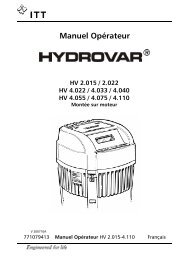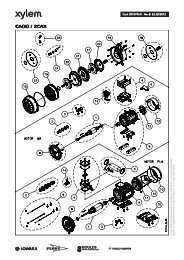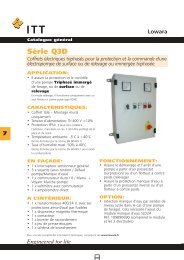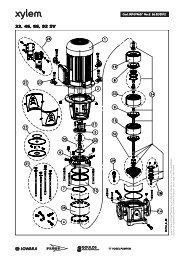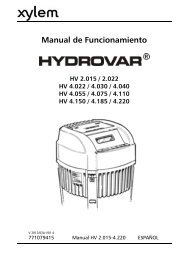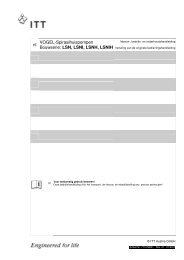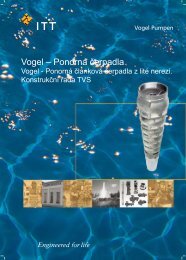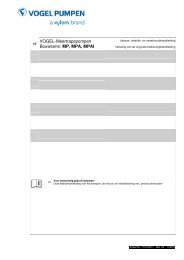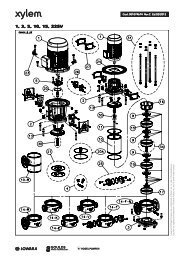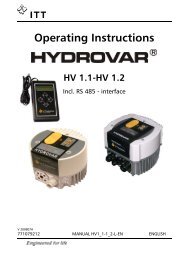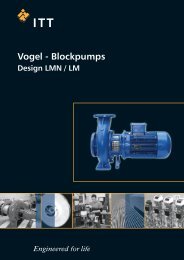LSB german_french_english 771076129 - Water Solutions
LSB german_french_english 771076129 - Water Solutions
LSB german_french_english 771076129 - Water Solutions
You also want an ePaper? Increase the reach of your titles
YUMPU automatically turns print PDFs into web optimized ePapers that Google loves.
Installation, Operation and Maintenance InstructionModel <strong>LSB</strong>6.4.2 Abrasive MediaOn pumping liquids with abrasive componentsan increased wear at hydraulic and shaft sealingmust be expected. The intervals of inspectionshould be reduced compared to the usualtimes.6.4.3 Permitted number of startsThe permitted number of starts of the pump must notbe exceeded, see diagram 6.max. perm. starts/h100,010,01,01 10 100 1000Motor power [kW]diagram 6With electric motors, the permitted number of starts isgiven in the attached motor operating instructions.If two different figures are given, the lower figure isvalid.6.5 LubricationThe pump has no bearings and, therefore there´s noneed for lubrication.For possibly required lubrication of the motor bearingsrefer to the Operation and Maintenance Instructions ofthe motor supplier.6.6 MonitoringIn areas endangered to explosion it isrecommended to monitor the temperature of thebearings and the vibrations of the pump.Regular monitoring and maintenance will extendthe life of your pump or pump system.Check pump for leaks at least once a week.Check the regulating and monitoring devices ofany sealing or flushing systems once a week toensure that they function properly. Outgoingcooling water should be handwarm.Pumps which are exposed to corrosive chemicalsor to wear through abrasion must be inspectedperiodically for corrosion or wear and tear. Thefirst inspection should be carried out after sixmonths. All further inspection intervals should bedetermined on the basis of the state of the pump.6.7 Shutting downClose the valve in discharge pipe right before(max. 10 seconds) switching off the motor. This isnot necessary if there is a spring-loaded checkvalve.Switch off motor (make sure it runs down quietly).Close the valve on suction side.Close auxiliary circuit.On danger of freezing empty pump and pipescompletely.If pump remains under pressure and temperaturewhen stationary: leave existing sealing andflushing systems switched on.The shaft sealing must remain sealed if there is arisk of air being sucked in (in the event of supplyfrom vacuum systems or parallel operation withshared suction pipe).6.8 Storage / longer periods of nonoperation6.8.1 Storage of new pumpsIf the putting into operation shall happen a longerperiod after the delivery, we recommend the followingmeasures for the storage of the pump: Store pump at a dry place. Rotate pump by hand at least once a month.6.8.2 Measures for longer putting out of operationPump remains installed and in ready for operation: Test runs of 5 min. duration must be made inregular intervals. The span between the test runsis depending on the plant. However, it should bemade once a week, at least.6.8.3 Longer periods of non-operationStart-up must be handled like initial start-up (seechapter 6).a) Filled pumps Switch stand-by pumps on and immediately offagain once a week. Possibly use as main pump. If the stand-by pump is under pressure andtemperature: leave all existing sealing and flushingsystems swiched on. Replace motor bearings after 5 years.b) Drained pumps Turn shaft at least 1x week (do not switch onbecause of dry running). Replace motor bearings after 5 years.<strong>LSB</strong> 100-<strong>english</strong> page 82 Revision 02Artikel Nr. <strong>771076129</strong> Ausgabe 01/2010



